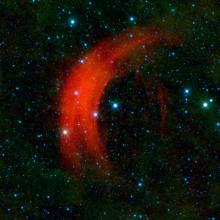Listen to today's episode of StarDate on the web the same day it airs in high-quality streaming audio without any extra ads or announcements. Choose a $8 one-month pass, or listen every day for a year for just $30.
You are here
Kemble’s Cascade
If you look long enough and hard enough, you’re bound to find an interesting pattern of stars in the night sky. Stargazers have logged all kinds of circles, rectangles, and many other patterns.
One of those is known as Kemble’s Cascade. It’s a lineup of about 20 stars. They’re not actually related to each other — they just happen to line up that way in the sky. There’s a big variation in the brightness of the stars. But the whole string is visible with good binoculars on a dark, moonless night.
Such a pattern is known as an asterism. It’s not a constellation, but it is a group of stars that form a pattern. The most famous asterism is the Big Dipper — the body and tail of Ursa Major, the great bear.
Kemble’s Cascade was discovered in 1980, by Father Lucien Kemble, a Franciscan friar and a well-known amateur astronomer in his homeland of Canada. He found the array of stars using a pair of binoculars. He then sent a letter to a columnist at Sky & Telescope magazine, describing the alignment as “a beautiful cascade of faint stars.” One end of it stops near the faint star cluster NGC 1502.
The writer published a story about it, and named it Kemble’s Cascade in the friar’s honor.
Kemble’s Cascade is in Camelopardalis, the giraffe. The faint constellation is fairly low in the northeast at nightfall. Kemble’s Cascade is arrayed beneath a triangle of faint stars that outlines the giraffe’s body.
Script by Damond Benningfield






